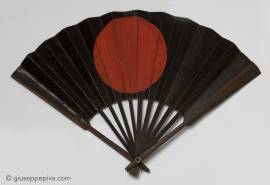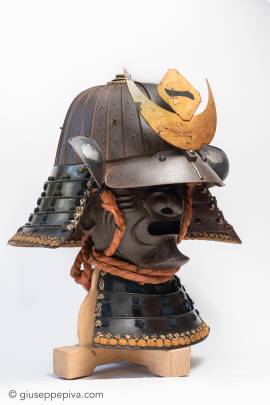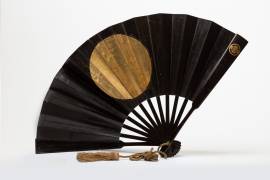TessenFighting fanMid Edo Period (1615 - 1867), Iron, paper with pigments and bamboo.Menhari-gata (opening fan), sensu-gata (enlongated shape)Lenght: 35.5Iron fan with an elegant shape, with nine bamboo ribs.Customarily carried in the hands or tucked in the obi (belt), the folding fan played a significant role in Japanese etiquette, especially on formal occasions, and was rarely ever out of a samurai's possession. Perhaps because it was considered such an ordinary item, it was easily employed as a suitable side arm with only minor modifications. These weapons, called tessen,...
WORKS FOR SALE
Signed by Myōchin Muneaki and dated 1853Signature: Kaei 6 - Ushidoshi Oshu Nihonmatsu-ju Myōchin Ki (no) Muneaki sakuMade in 1853 by Myōchin Ki Muneaki in Nihonmatsu castle. The helmet is a 24-plate suji kabuto with five rows of visible rivets. The shape is rather tall (koseizan), and the fittings, such as the visor (mabezashi) and the maedate holder (haraidate), are beautifully crafted. The five-plate shikoro bears on the fukigaeshi a rare kamon (family crest) made of silver maki-e lacquer, depicting the butterfly (hachō) used by the Taira clan in the ancient times and later taken up by...
GunsenWar fanEdo Period (1615-1868)Lacquered wood, paper, gold foil, pigmentsSpoke length: 33.5 cmWide: 56 cm The outer spokes bring a gilt kamon (family crest) of mokko (melon) type.Folding military fans (gunsen) were used by samurai while camp during wartime. They usually have eight or sixteen tines, with a broader tine on either end. The sun and the moon, in gold or silver and crimson, adorn the fan’s faces. While their original function was straightforward- to cool the user in hot weather- folding fans were used for military purposes beginning in ancient times. During the...
Copyright © 2016 - giuseppe piva - VAT: 05104180962










